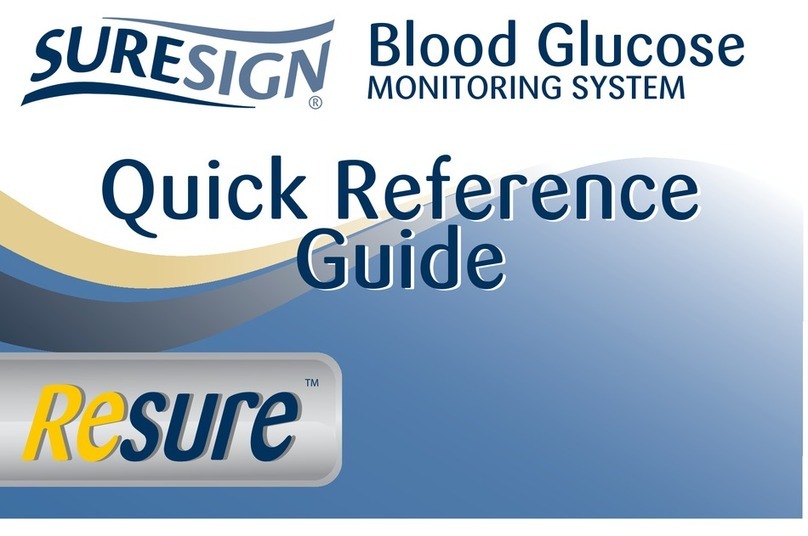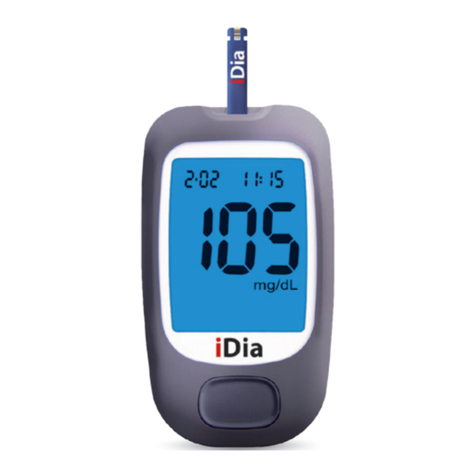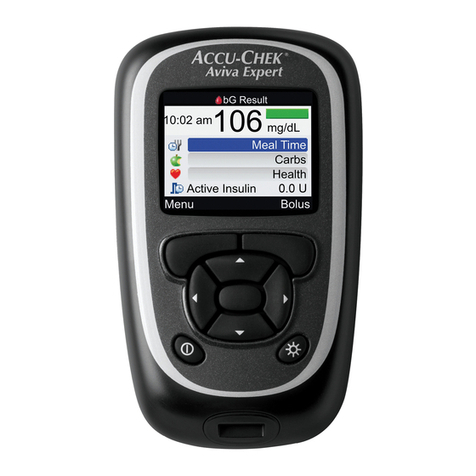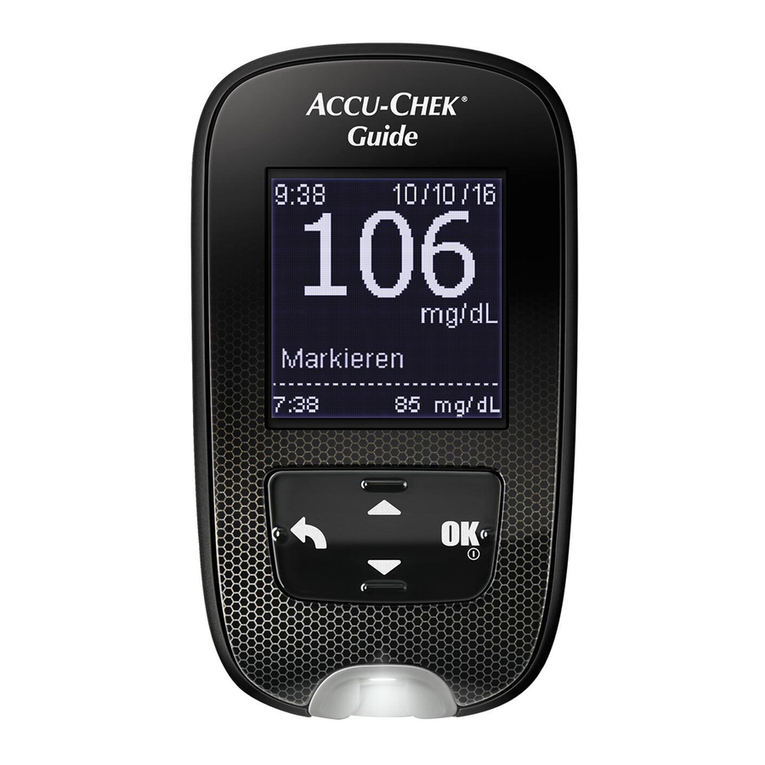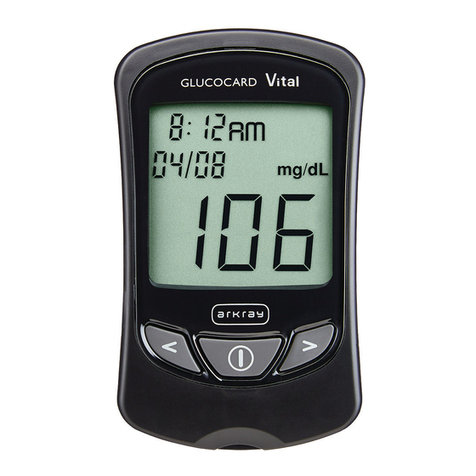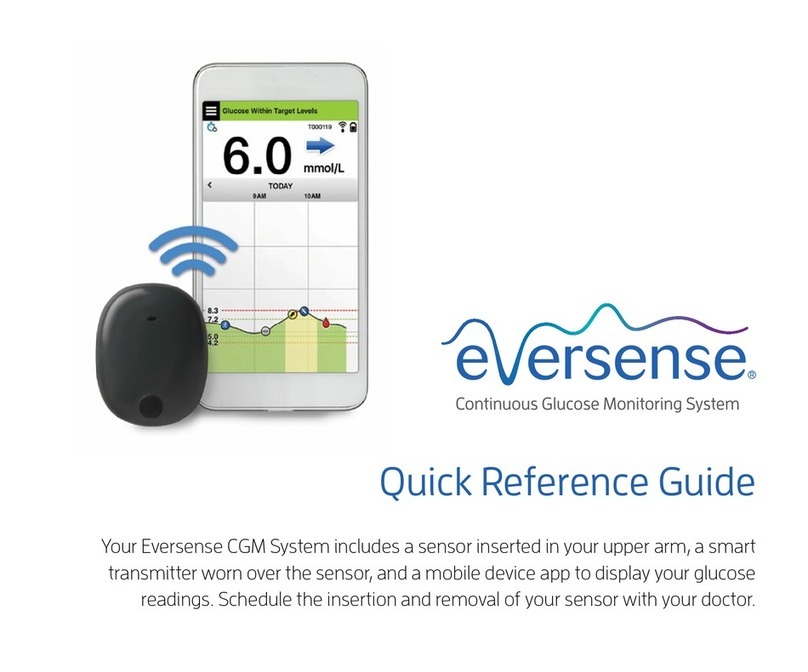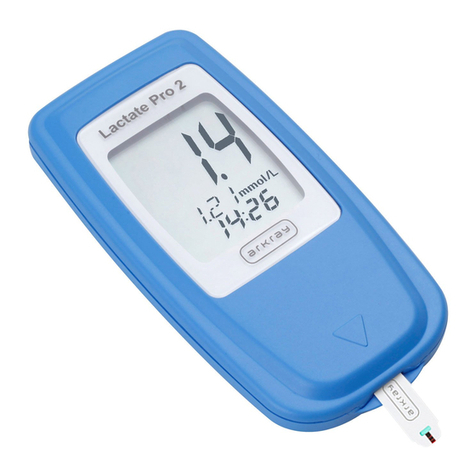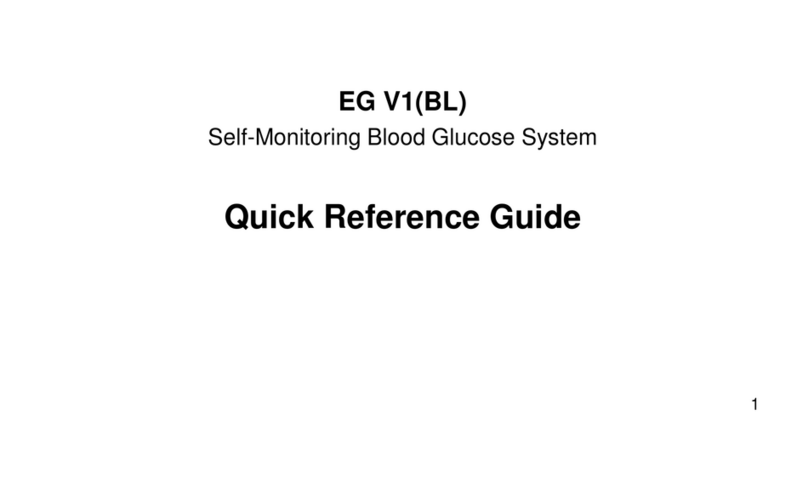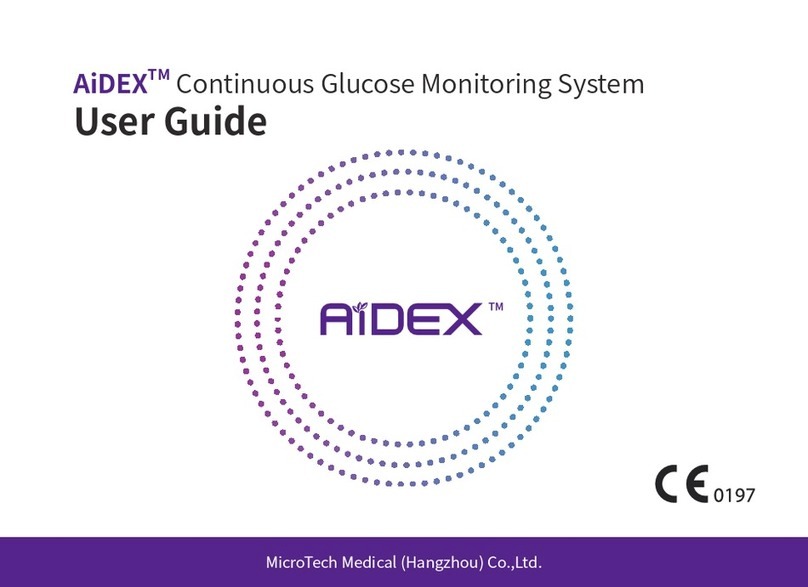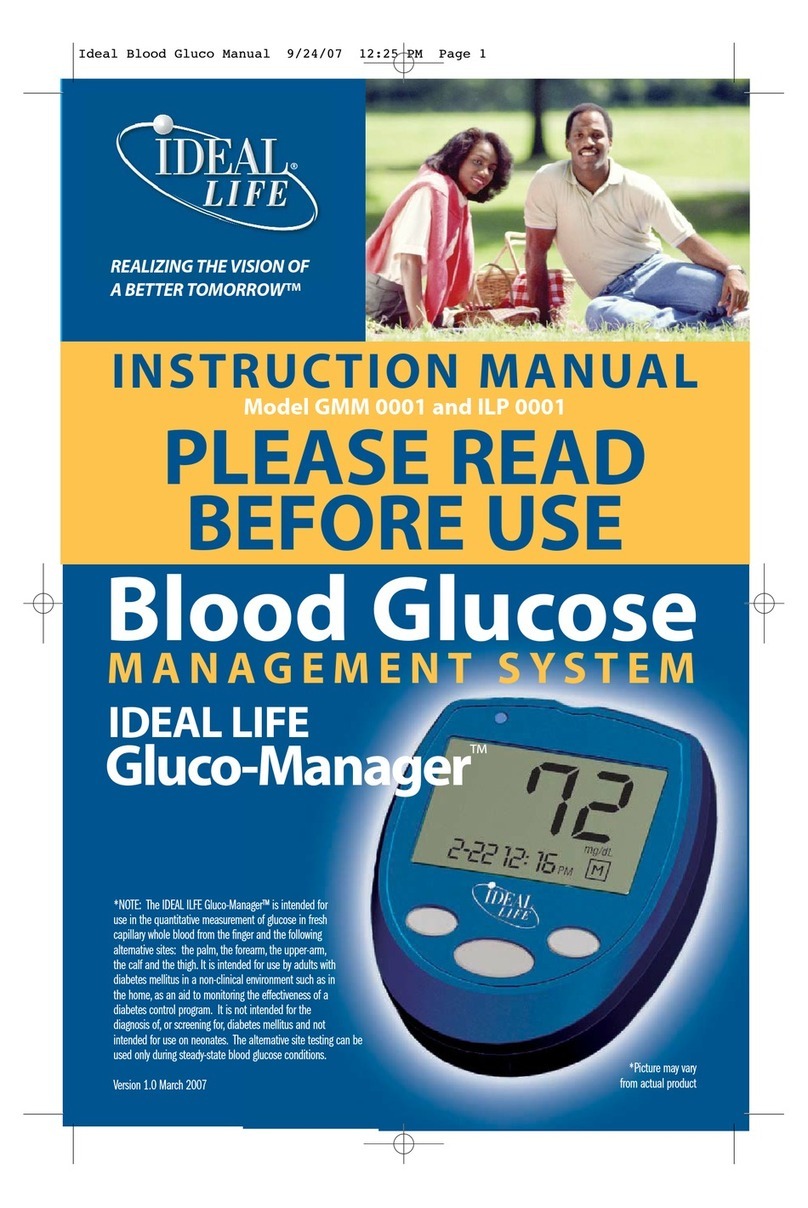HMM SmartLAB User manual

User Manual
HMM Diagnostics GmbH
Friedrichstraße 89
D-69221 Dossenheim, Germany
www.hmm.info
Self-Monitoring Blood Glucose System with wireless data transfer
Please read this manual thoroughly before first
using this device


41
ENGLISH
Contents
I. Introduction 43
Measuring principle 44
Intended use 44
Important information 45
Note on smartLAB®nG „NO CODE“ test strips 47
II. Your smartLAB®global W nG 48
Display & functions 48
Specifications 48
The smartLAB®nG test strips 49
Explanation of symbols 50
Set content 50
III. Setup & Operating procedures 51
Installing batteries 51
Function check 52
Wireless Data transfer 53
Notes on using smartLAB®nG blood glucose test strips 55
Running a blood glucose test 56
Alternate Site Testing (AST) with the transparent cap 59
Understanding your test results 60
Optional: Control Solution Testing 63

42
IV. Miscellaneous 67
Maintenance 67
Troubleshooting 68
Limitations of the measurement procedure 72
Regularity and Safety Notice 74
Warranty 75

43
ENGLISH
I. Introduction
Thank you for using the smartLAB®global W nG Self-Monitoring
Blood Glucose System. This system was produced in close associa-
tion with diabetes health care professionals, hospitals and, most
importantly, people with diabetes. The measuring results can help
you determine the effects of food, exercise and diabetes medica-
tions.
Your smartLAB®global W nG glucose system was designed to be de-
pendable, easy-to use, compact, lightweight and portable to assist
you in monitoring your blood glucose on a regular basis. Please
read this manual thoroughly before you begin testing. It pro-
vides you and your diabetes care team with important information
and step-by-step direction to use meter correctly. Although your
smartLAB®global W nG System is easy to use, you should consult
your healthcare professional (this may be your doctor, diabetes
nurse educator or pharmacist) for instructions on how to use the
system. The only way to obtain accurate results from any system is
to make sure you correctly use it. If you have any concerns, please
call your authorized distributor in your country during business
hours.
The smartLAB®global W nG System is an ANT+ and Bluetooth® Smart
device. It supports the ANT+ device profile (V. 2.1) and is kompatible
with receiving devices (such as PC and Smartphones) that support
the ANT+ weight scale device profile. With the integrated Bluetooth®
Smart the smartLAB®global W nG System can also sent data via BLE
to a corresponding receiver. You can then transmitt your values
wireless to these receiving devices.

44
Measuring principle
The smartLAB®global W nG Self-Monitoring Blood Glucose System
is designed to allow rapid measurement of blood glucose by using
an electrochemical biosensor technology. This system employs a
disposable dry reagent strip technology, based on the FAD-binding
glucose dehydrogenase.
Each test strip features an electrode containing FAD-binding glu-
cose dehydrogenase. A capillary blood sample is applied to the col-
lecting area of the strip, and is automatically drawn into the reac-
tion zone, where the FAD-binding glucose dehydrogenase catalyzes
the glucose dehydrogenation. It will produce gluconolactone.
During the reaction, a mediator transfers electrons to the electrode
surface and generates a current. The amount of the current is pro-
portional to the amount of glucose present in the blood sample.
After 5 seconds, the smartLAB® global W nG will show glucose con-
centration on the screen
Intended use
This blood glucose meter is a self-test IVD medical equipment and
intended for both home testing and for professional use to moni-
tor the blood glucose value from capillary whole blood and venous
whole blood. It is used outside the body only (In-vitro diagnostic
use). The meter should be used only with smartLAB®nG blood glu-
cose test strips.

45
ENGLISH
Important information
• The smartLAB® global W nG blood glucose meter is designed and ap-
proved for testing venous whole blood or fresh capillary whole blood
samples from your fingertips, palm and forearm. The meter is for in
vitro diagnostic use ONLY (for testing outside the body). It should not
be used to diagnose diabetes.
• The smartLAB® global W nG blood glucose meter can only be used with
smartLAB®nG Blood Glucose Test Strips. Other test strips will give in-
accurate results.
• Severe impact may cause the meter to malfunction. Do not disas-
semble the meter as it may damage components inside and cause an
incorrect reading. The warranty will be void if the meter has been
disassembled.
• Testing is not valid for neonatal blood specimens.
• Incorrect results may occur when performing the test. If you believe
you are not feeling well, please contact your healthcare professional
immediately.
• Always keep the meter clean and store it in a safe place. Protect from
direct sunlight to ensure a longer lifespan.
• The strip slot should be kept free from dirt, dust, blood stains, and
water stains.
• Do not store the meter and test strips in a car, a bathroom or a refri-
gerator. And the meter, strips and lancing device should be kept away
from children or pets.

46
• Remove batteries if the meter will not be used for one month or more.
• Store the kits in a dry place with temperature range is 2 to 30°C (35.6
to 86 °F). Keep away from direct sunlight and heat.
• Store your test strips in their original vial only. Do not transfer them
to a new vial or any other container.
• Indicate the date you open the vial. Discard all unused strips im-
mediately after 90 days from open date. The strips are for single use
only.
• You should not test critically ill patients with home-use blood glucose
meters.
• Warning for potential biohazard: Healthcare professionals using this
system on multiple patients should be aware that all products or ob-
jects that come in contact with human blood, even after cleaning,
should be handled as if capable of transmitting a viral disease.
• Please dispose device according to the local rule of the disposition of
electronic device/ accessory waste.
• If the equipment is used in a manner not specified by the manufactu-
rer, the protection provided by the equipment may be impaired.
Do not touch the test strip with wet hands
Do not use expired test strips
(see expiration date on the strip vial)
Do not bend, cut or twist the strip

47
ENGLISH
Consult with your healthcare professional before testing
on your palm or forearm.
Altitude up to 3,048 meters above sea level has no effect
on readings.
Health-Related Information
• If you are experiencing dehydration, frequent urination, low blood
pressure, shock or hyperosmolar hyperglycemic nonketotic coma
(HHNKC), you may get a test result that is lower than what your blood
glucose really is. If you think you are dehydrated, call your healthcare
professional right away.
• If you have followed the steps in the user’s manual, but still have
symptoms that do not seem to match your test results, or if you have
questions, please contact your healthcare professional.
• Please read your test strip instructions carefully for additional health-
related information
•
Note on smartLAB® nG „NO CODE“-test strips
The smartLAB®nG blood glucose test strips compatible with
smartLAB®nG glucose systems need not to be coded, any more.

48
II. Your smartLAB®global W nG
Display & functions
Measuring
result
Measuring
unit
Apply
blood or con-
trol solution to
the test strip
Battery power
Thermometer
Wireless
Specifications
1. Type: smartLAB®global W nG
2. Measuring range: 20~630 mg/dL
(1.1~35.0 mmol/L)
3. Measuring duration: 5 seconds
4. Time mode: AM/PM - 24 hours
5. Memory: 480 values
6. Operating temperature: 10°C~40°C
(50°F~104°F)
7. Storage Temperature: -20°C ~50°C
(-4°F~122°F)
8. Relative humidity: RH ≤90%
9. Blood sample: ≥ 0,6 µL capillary
whole blood
10. Calibration: Plasma equivalent
11. Hematocrit (Hct): 30-55%
12. Battery type: 2 CR 3V Lithium
batteries
13. Battery life: approx. 500 measure-
ments
14. Display-size: 30 x 30 mm
15. Meter dimensions: 80 x 50 x 5 mm
16. Weight: 30g (without batteries)
17. Data transfer: wireless through
integrated ANT and BLE module
18. Transportation temperature: -20°C
~50°C (-4°F~122°F)
19. Transportation humidity: RH ≤90%

49
ENGLISH
The smartLAB®nG test strips
Note: You can find the test strip expira-
tion date on the vial label next to the
symbol.
Expiration date
Vial opening date (please
note)
Electrode
Insert direction
Grip zone
Reaction zone
Aperture Application zone

50
Explanation of symbols
+
Caution
This product meets the requirements of Directive
98/79/CE for in vitro diagnostic medical devices.
Lot number
Expiration date
For in vitro diagnostic use only
Use Lithium battery CR 2032 3V
Single use only
Storage temperature
Manufacturer
Before use, read manual first
Catalogue number
Serial number
Control solution
Opening date of test strip vial
Set contents
1 smartLAB®global W nG blood glucose meter
1 User manual
1 hard box
2 CR 2032 3V batteries
1 smartLAB® lancing device
1 smartLAB®Check Strip
1 smartLAB® Quick Start instruction
10 smartLAB® lancets
10 smartLAB®nG blood glucose test strips
1 smartLAB®nG blood glucose test strip instruction

51
ENGLISH
III. Setup & Operating procedures
Installing batteries
The meter uses 2 CR 2032 3V Lithium
batteries. Batteries will normally last
for aprox. 500 tests. Other types of CR
3V lithium batteries are also acceptable,
yet the capacity of test times may differ.
Install the batteries, by removing the plastic protection when you
first use the meter or replace with new batteries when the “LP” mes-
sage and the low battery symbol appear on the LCD display. Open
the battery lid on the back side of the smartLAB®global W nG meter
and insert batteries with plus sign to top. First insert the battery on
the right side and then press the left side down until it clicks. Close
the battery lid. The display will light up and all symbold will blink
for around 10 seconds. Afterwards you can use the device.
Note:
1. Remove the batteries when not using the meter for one month
or longer.
2. Values won’t be deleted when the batteries are replaced.
3. The device needs to be set again after battery change. Please
make sure that the device is close to a corresponding receiving de-
vice for settings.
4. The device will try to contact the gateway within the first 10
minutes after inserting batteries. If no connection is possible, “ERR
002” will show on the display. The device will now try to connect to
gateway in a certain interval in the background.
Low battery symbol

52
Meter, batteries, lancets, test strips etc. must be disposed of
according to local regulations at the end of their usage.
Function check
You can carry out a function check with the Check Strip which is
included in your meter set. You do not have to do the function
check before every measurement. It helps you to control if your
smartLAB®nG meter works properly, from time to time, though.
1. Insert check strip into the meter:
Make sure your check strip is inserted with writing to top. The meter
will turn on automatically and the display will show „CHK“.
2. Check message in LCD display:
The function check will take approx. 3 seconds. The check can pro-
duce the following messages on the display:
•„OK”-yourmeterworksproperly
•„FAL“-changebatteriesandcheckagain.Ifthemessagestillap-
pears, please refer to your local supplier.
After showing “OK” the device will start to send measured data. If
device has not been set yet by the system it will be set now. After-
wards the data will be shown on the screen.
3. Remove check strip:
The meter will turn off automatically after removing the check strip.
Please keep the check strip in the soft case of the meter.

53
ENGLISH
Wireless Data transfer
You can connect your smartLAB®global W nG with a partner device
which fulfills the standard protocol of ANT+ or BLE wireless data
transfer. You can transfer measured blood glucose values automati-
cally and wireless to the device. Partner devices could be laptops,
smartphones, tablets or any other ANT+ or BLE-capable device.
The communication will be enabled by a gateway* which can be
installed on PC, Smartphone or Tablet.
To allow a data transfer to a portal your smartLAB®global W nG
needs to be set by the system. When using the device for the first
time and removing the battery protection the display will blink for
5 seconds which indicates that the device is trying to communicate
with the gateway to set the device.
After each measurement the device will send the data to the gate-
way. Saved Data will be transfered automatically every 30 minutes
or together with a new Mesaurment. You can also manually transfer
measured data. Please go to Chaper “Manually transfer not sent
data”.
When transfering data, the wireless symbol “W” will flash on the
display.
Note: The BLE or ANT+ installation on the according partner device
varies and can not be explained in every detail, here. Please read
the partner device’s user manual thoroughly on how to activate BLE
or ANT and how to connect the device to your smartLAB®global W
nG.
* For more information on the gateways please visit www.hline-online.com

54
Manually transfer not sent data
You can initialize a manual data tranfer by following these steps:
• Insert the Check Strip into the test strip slot. “Chk” and “OK”
should show.
• On the display the wireless symbol will flash afterwards; the
device is now trying to communicate with gateway and send all
data, which have not been send yet.
• The last 20 measured values will show display. The results will
be shown chronologically on the display, the rst for 3 se-
conds, the values afterwards for 1 second.
• The device will turn off when removing the Check Strip.

55
ENGLISH
Notes on using smartLAB® nG blood glucose test strips
• Use only with smartLAB®nG Blood Glucose Meters.
• Run a control solution test every time you open a new box of
test strips
• Keep the test strips in their original bottle.
• After you take a test strip out of the bottle, tightly close the
bottle immediately. This keeps the test strips dry.
• Use the test strip within three minutes after taking it out of
the bottle.
• The strip is for single use only. Do not reuse it.
• Record the date you open the test strip bottle. Be sure to check
the expiration date on the test strip bottle. The test strip is
good for 6 months from the date the bottle is opened or until
the expiration date on the bottle, whichever comes first.
• Store the test strip bottle and your meter in a cool dry place.
• Store the test strips between 2°C ~30°C (36°F - 86°F). Do not
freeze.
• Do not apply blood or control solution to the test strip before
you insert it into the meter.
• Do not touch the test strip with wet hands. Do not bend, cut,
or twist the test strips.

56
Running a blood glucose test
1. Preparations
Before running a blood glucose test, make
yourself acquaint with the test strips and the
lancing device. Keep all required materials
ready for use: your smartLAB®global W nG
meter, the smartLAB®nG test strips and the
smartLAB®lancing device including lancets.
Wash your hands thoroughly with warm water
before collecting the blood sample. Rinse your hands thoroughly.
2. Switch on the meter
Take a strip out of the vial and immediately close it. Insert the strip
into the meter in the direction of the arrow on the strip. The meter
turns on automatically. The symbol for applying blood will appear
on the display.
Note: If the device could not be set by the gateway
after changing the batteries you can still run a blood
glucose test. When inserting a test strip the display will
show „nod“. After that the symbol for applying blood
will appear on the display.
3. Collecting a blood sample
When the blood drop flashes on the display, gen-
tly massage the part of your finger tip which you
obtain a drop of blood from using the lancing
device. Place the lancing device against the pad
of your finger. Press the trigger button to activate the lancing de-
vice.

57
ENGLISH
4. Blood glucose measurement
Hold the application zone of the test strip vertically onto the blood
sample. The blood is automatically sucked in the reaction zone of
the test strip. Be sure to get enough blood on the strip’s reaction
zone, otherwise, an inaccurate reading may result. The signal tone
indicates that enough blood entered the reaction zone. The meter
will now start with the measurement which will last 5 seconds. The
LCD display shows the remaining time of measurement in seconds.
Afterwards the note „OK“ indicates a correct measurement. The
measurement is finished with another signal beep and the meas-
ured value is shown on the display.
5. Storing memories
The displayed result is automatically stored in the memory of the
meter. If more than 480 results are reached, the oldest one is de-
leted.
After every measurement the meter tries to connect to another pre-
installed ANT or BLE partner (please refer to the chapter “Wireless
data transfer” in this manual to learn how to connect your device
with a ANT or BLE partner). The Wireless-sign will start flashing. If
a connection can be established, the result will be transferred auto-
matically. In case no connection was found, “ERR” and the Wireless-
sign appears on the display. Please make sure that you set up your
wireless connection correctly according to the instructions in the
manual of your partner device.

58
Note: If the glucose value could not be transmitted via ANT or BLE, it
will still be saved on the internal memory of your smartLAB®global
W nG.
Once the connection can be established the next time, all values
that have been measured in the meantime will be transferred to the
partner device.
6. Discarding used test strips and lancets
Write down the measured result in your personal diabetic log book
and take the test strip off the strip slot. The meter turns off. If you
don’t take off the test strip, the meter will turn off automatically
after 5 minutes.
In order to discard lancets from the smartLAB® lancing device, re-
move the end cap and carefully pull the used lancet out of the hol-
der. Dispose the lancet according to local regulations, in order to
avoid hurting other people.
Reading stored test results from memory
You can read the last 20 test results on the internal memory of
your smartLAB®global W nG meter by inserting the check strip.
The results will be shown chronologically on the display. Further
results can be seen in the corresponding portal.
Table of contents
Popular Blood Glucose Meter manuals by other brands
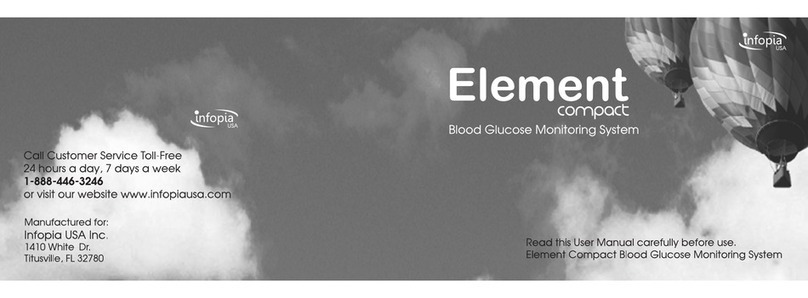
Infopia
Infopia Element compact user manual

Plusmed
Plusmed fasTTest DiagnoPRO pM-900 instruction manual
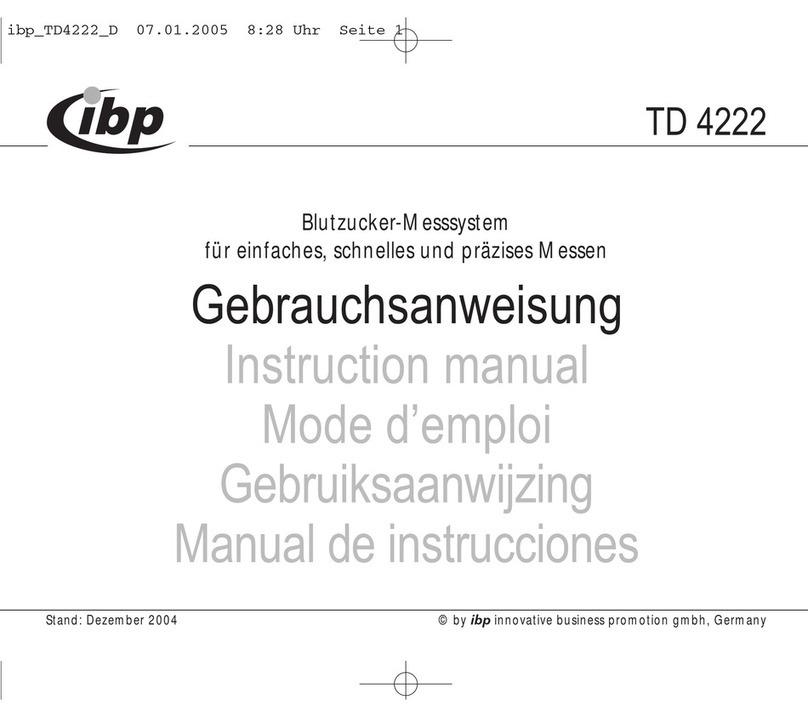
IBP
IBP TD 4222 instruction manual

GlucoRxQ
GlucoRxQ TD-4235B operation instruction

Ascensia Diabetes Care
Ascensia Diabetes Care Contour Next user guide

Nidek Medical
Nidek Medical NT-510 Operator's manual

